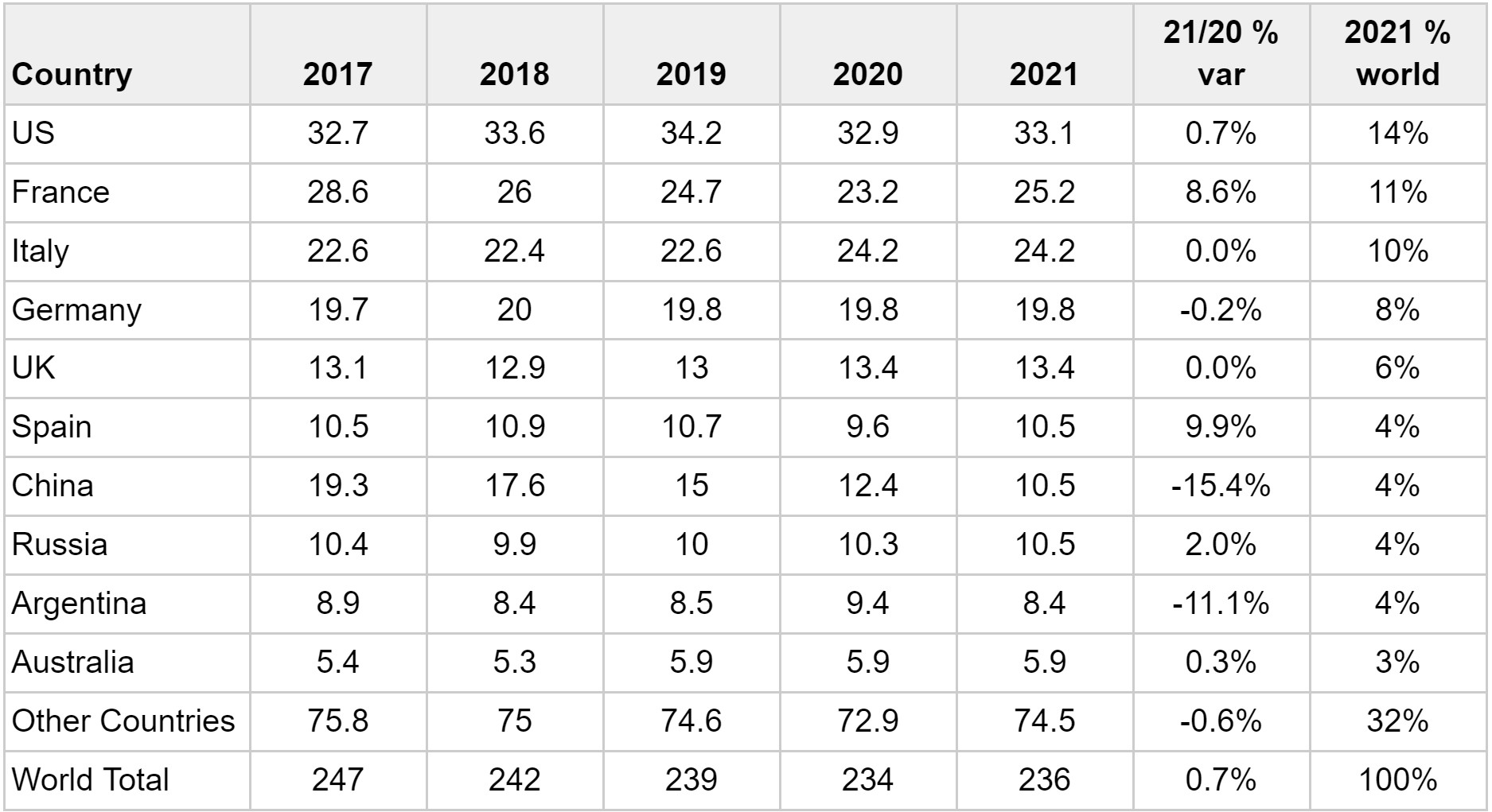Overview of Global Wine Consumption 2021

International Wine Consumption
World wine consumption in 2021 is estimated at 236 mhl (million hectolitre), which is an increase of 2 mhl compared to 2020, a YoY increase of 0.7%. 2021 marks the first year of positive growth following a three-year decline that started in 2018 and lasted until 2020. The declining trend was driven by a decrease in Chinese consumption, which lost an average of 2 mhl per year during the period. This downward trend was exacerbated by the COVID-19 pandemic in 2020, with closures in the hospitality sector resulting in depressed consumption on a global scale. Global wine consumption recovered in 2021, but consumption trends differ significantly between countries and geographical regions around the world.
Figure 1: Global Wine Consumption 2000-2021

Source: International Organisation of Vine and Wine (OIV)
North America
The USA remains the largest wine-consuming country in the world in 2021, with an estimated consumption of 33.0 mhl, a volume in line with the 2020 consumption level. The USA has proven to be a resilient market during the COVID-19 pandemic, maintaining a relatively stable consumption level despite the restrictions imposed by the COVID-19 pandemic. On the other hand, Canada consumed an estimated 4.2 mhl in 2021, which is 4.5% less than 2020, marking the fourth straight year of declining consumption in Canada. The decrease in consumption can be attributed to consumers opting for less but more premium wine and a decreased preference for wine among young alcohol consumers.
Europe
France is the largest consumer in Europe, and the second-largest in the world, with a 2021 consumption volume of 25.2 mhl. The consumption level is 8.6% higher than 2020 and 2% higher than the pre-pandemic level of 2019, highlighting a significant recovery following COVID-19 restrictions. The recovery of French consumption is likely due to the return of tourism in 2021. Italy, the third-largest global consumer, has an estimated wine consumption of 24.2 mhl in 2021, a level in line with 2020. This is the highest wine consumption level recorded in Italy since the global financial crisis of 2008. Italy experienced growth in wine consumption during the pandemic despite bar and restaurant closures due to increased off-premise sales, especially of low-priced wines. Germany recorded consumption of 19.8 mhl in 2021 which is in line with 2020 consumption levels. Germany maintained a steady consumption level throughout COVID-19 due to its robust economy and increased consumption at home and through online meetings or wine tastings with family and friends.
The UK consumed an estimated 13.4 mhl in 2021, a volume in line with 2020 consumption levels and 3.4% higher than its five-year average. UK consumption has remained stable during the pandemic due to an increase in off-premise wine sales and consumption which compensated for the approximately 31-week closure of on-trade premises during national lockdowns. Spain has increased its wine consumption volume by 9.9% in 2021, reaching 10.5 mhl, a figure in line with pre-pandemic levels. The increase in Spanish consumption is largely due to the increase in tourism following COVID-19 restrictions as tourists consume a large volume of wine in Spain.
Table 1: Wine Consumption per Country 2017-2021

Source: OIV
Asia
China consumed an estimated 10.5 mhl in 2021, indicating a 15.4% YoY decrease compared to 2020. China experienced a boom in consumption that peaked at 19.3 mhl in 2017 whereafter consumption started to decline, losing an average of 2 mhl per year. The decline in Chinese consumption is a major contributing factor to the continual decrease in global consumption experienced in recent years. Russia’s wine consumption is estimated at 10.5 mhl, a rise of 2% compared to 2020, marking the third consecutive year of growth in Russian wine consumption. Young consumers under 35 years of age are driving wine consumption in Russia, breaking away from the tradition of spirits consumption favoured by older generations. The third-largest wine-consuming country in Asia is Japan, which consumed 3.3 mhl in 2021, marking a 5.4% decline compared to 2020. Japanese wine consumption behaviour shifted to less but more premium consumption during the pandemic, accounting for the lower consumption volume.
South America
Argentina, the largest wine consumer in South America, consumed 8.4 mhl of wine in 2021, a decrease of 11.1% with respect to 2020. Argentine wine consumption has been in a steady decline since the start of the 21st century. The primary underlying cause of decreased consumption is the reduced purchasing power of consumers caused by economic turmoil and continuously rising inflation, especially during 2021 when it experienced above 50% YoY inflation. On the contrary, Brazil, the second-largest market in South America, increased its consumption by 1.2% to 4.1 mhl in 2021, reaching a level of consumption last seen in 2000. Wine consumption growth in Brazil can be attributed to a broader consumer base, especially among consumers 35 years and older.
Australia and South Africa
Australian wine consumption is estimated at 5.9 mhl in 2021, only slightly higher than its 2020 level but is the highest consumption ever recorded in Australia. Wine consumption in Australia showed little variation during the pandemic due to a shift in consumption patterns from on-premise consumption to at-home consumption such as family events or online socialising. South Africa consumed an estimated 4.0 mhl in 2021, an increase of 27.5% compared to 2020. However, this level is still 5.3% lower than its five-year average and below pre-pandemic levels. South Africa experienced severe lockdown restrictions where local alcohol sales were banned for more than 160 days on four separate occasions in 2020 and 2021. South Africa is still recovering from lockdown restrictions with consumption expected to return to pre-pandemic levels in 2022.


